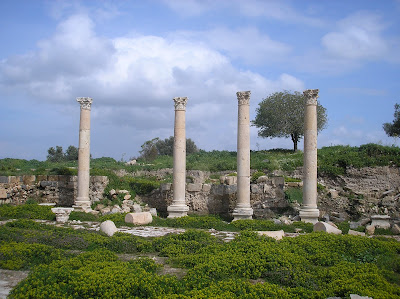
Another weekend spent in the city with a lot of work to do. Above and beyond the reports we have due at the end of this month and next, we also had an office real estate move to attend to this weekend. Change is the only constant, it seems. The team has been shifted from the previous (leaky, temperamental) "new" building to make room for permanent ministry staff who need to be closer to the powers that be. Consequently, we have been shifted into an older, government-owned building that is half-vacant. Despite the chaos this move creates at a very busy time, this new location is fine with me. Our "new" old space turns out to be larger and lighter and quieter, with great views and - a real bonus - it's within walking distance of my current apartment in the centre of town. This is a picture of the view from my office.
The move means I will get back to my old pedestrian ways and be able to cut down on using taxis as my main form of transportation. I have been taking cabs to and from work for over a month - since I moved into my current apartment. A 15-minute ride every morning and evening was costing about $5 a day - not so different from Toronto transit fares, really.
But cost savings and convenience aside, I will actually miss my morning conversations with taxi drivers. For one, it has been a chance to practice my arabic - and I think I have perfected "left", "right", "straight ahead" and "stop here please". And while some of the drivers have been grumpy or stand-offish or simply focused on listening to the morning call-in show, I would say that every second driver had something he wanted to talk to me about: the weather... his sons... the cost of living in Canada...his hometown of Hebron...his grandfather's house in Bethlehem just up the street from the Church of the Nativity. (The drivers I have encountered are almost universally Palestinian). I understand one tenth of what they say and nod and say "aiwa" (yes) and "shukran" (thank you) a lot.
I relish these interactions with a working world inhabited by regular folks. Since moving away from the the consultants' apartment and its protective embrace where everything was taken care of, now I have had to do real person things like track down the landlord to pay him for rent and fuel oil; buy kitchenware; get the drinking water delivered and paid for. I even went to a tailor this weekend to get a pair of trousers hemmed. I am stretching my vocabulary and learning a lot by simply being.

Here's a few things I have learned: first, business people are incredibly trusting. I owed back money on fuel oil for over a month - I could never catch the building owner at the right time. When I finally connected with him and paid up, apologizing profusely, his response: "Miss Hannah, it is fine. You can pay many months late. No problem. I know that you are good and you will pay."
The water delivery guys, based on a single call of inquiry, were more than happy to drop off a giant jug of water to my apartment sight unseen, no payment in advance. The information "apartment #8 - Mahmoud Safarini building" was enough for them. They definitely didn't catch my name. They knew I was good for the money, clearly. "No problem...mish mushkilla".

The second thing: there are eyes on the street. The "tailor for ladies" I went to today to hem my pants knew what building I lived in. "You are new here. You live next door. You are welcome any time, madam." I like it. It feels like someone has my back. (He also took care of my trouser hem in a 3 hour turnaround time and charged me about $1.75 for a really nice job.)
Unlike at home, where going to the dry cleaner or the corner store is the stuff you get done in between actually living your life, each of these tasks is its own mini adventure that stretches me in some way. This is why I am glad I am living here in a day to day world and, while I will always be a foreigner, I am something more than a passing tourist.













